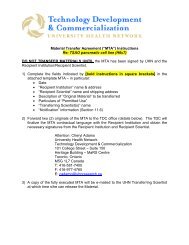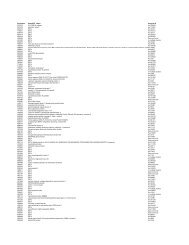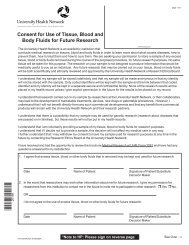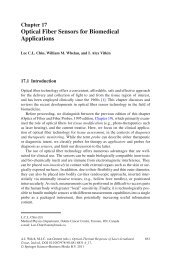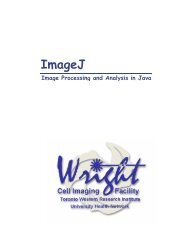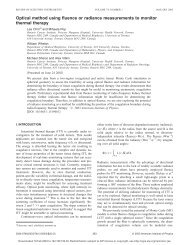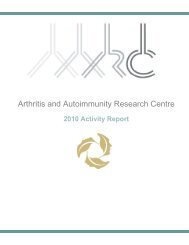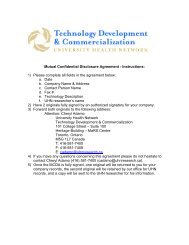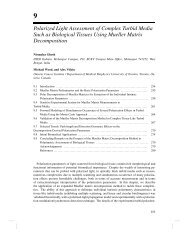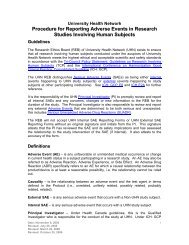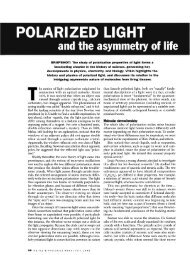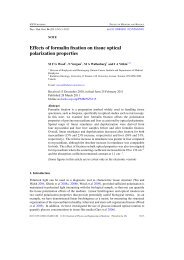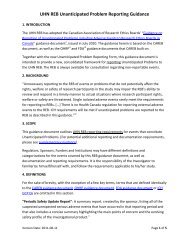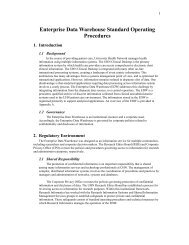Download the 2005 pdf - UHN Research
Download the 2005 pdf - UHN Research
Download the 2005 pdf - UHN Research
Create successful ePaper yourself
Turn your PDF publications into a flip-book with our unique Google optimized e-Paper software.
Although early studies<br />
of dyslexia focused<br />
on <strong>the</strong> ability to recognize<br />
letters, current<br />
studies focus on <strong>the</strong><br />
ability to work with <strong>the</strong><br />
individual sounds<br />
that make up words.<br />
Risk Factor for<br />
Dyslexia Identified<br />
Dyslexia is an inherited<br />
language-based learning<br />
disability and new research<br />
by Dr. Cathy Barr provides<br />
evidence that <strong>the</strong> region<br />
containing <strong>the</strong> gene called<br />
EKN1 may be a risk factor<br />
for <strong>the</strong> disorder.<br />
Following up on studies<br />
by o<strong>the</strong>rs, Dr. Barr examined<br />
<strong>the</strong> relationship of <strong>the</strong><br />
EKN1 gene to dyslexia in<br />
children aged six to sixteen,<br />
who were recruited from<br />
148 families with known<br />
reading difficulties. Her<br />
genetic analysis revealed<br />
that <strong>the</strong> chromosomal<br />
region containing this gene<br />
contributes to reading ability<br />
and reading-related<br />
processes.<br />
Says Dr. Barr,“Our findings<br />
support <strong>the</strong> idea that<br />
<strong>the</strong> region of <strong>the</strong> EKN1<br />
gene may be involved in<br />
dyslexia, but fur<strong>the</strong>r studies<br />
are necessary to determine<br />
<strong>the</strong> precise relationship of<br />
<strong>the</strong> gene to <strong>the</strong> disorder.”<br />
Mol Psychiatry. 2004 Dec;<br />
9(12): 1111-21.<br />
<strong>UHN</strong>+ PARTNERS=<br />
Insight into <strong>the</strong> Cause of Parkinson’s Disease<br />
Malfunctions in <strong>the</strong> parkin<br />
gene are a major cause of<br />
Parkinson disease, and<br />
new research by TWRI/TWH’s Dr.<br />
Andres Lozano, student Suneil Kalia,<br />
and post-doctoral fellow Sang Lee,<br />
along with colleagues at <strong>the</strong><br />
University of Ottawa, McGill<br />
University and <strong>the</strong> University of<br />
Toronto, reveals ano<strong>the</strong>r way in<br />
which <strong>the</strong> parkin gene can be compromised.The<br />
finding may lead to<br />
new drugs for treating <strong>the</strong> disease.<br />
If not removed from <strong>the</strong> cell, damaged<br />
proteins clump toge<strong>the</strong>r forming<br />
aggregates—a lethal consequence<br />
found in many neurodegenerative<br />
diseases. Part of <strong>the</strong> cell’s “garbage<br />
disposal system”, parkin tags <strong>the</strong>se<br />
damaged proteins for destruction.<br />
The research team found that a<br />
protein called BAG5 prevents parkin<br />
from doing its job. BAG5 also inhibited<br />
parkin’s helper-protein, Hsp70.<br />
“High levels of BAG5 inhibited <strong>the</strong><br />
actions of parkin and Hsp70 resulting<br />
in enhanced neuronal cell death,”<br />
says Dr. Lozano.“Our results propose a<br />
mechanism for <strong>the</strong> cause of neurodegeneration<br />
in Parkinson’s disease and<br />
o<strong>the</strong>r diseases, and points to BAG5 as<br />
a potential <strong>the</strong>rapeutic target for<br />
Parkinson's patients.”<br />
Neuron. 2004 Dec 16; 44(6): 931-45.<br />
UNIVERSITY HEALTH NETWORK 29



